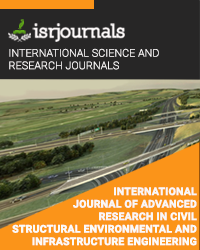an experimental study on vehicular emission dispersion through single storied building model configurations
Dr. M.K.KRISHNA,Dr.R M Mahalinge Gowda
Published in International Journal of Advanced Research in Civil,Structural,Environmental and Infrastructure Engineering and Developing
ISSN: 2320-723X Impact Factor:1.7 Volume:2 Issue:3 Year: 14 February,2016 Pages:112-121

Abstract
ABSTRACT-The problem of plume dispersion around urban buildings has been investigated by physical modelling using arrays of buildings- like obstacles at scale 1:100 in boundary layer wind tunnel for single storied buildings and compared with field data. The particular effect of obstacle width- to - height ratio (S/H) was examined for a fixed obstacle plan area density. In comparison, experimentally observed σz values are below the field values. Again, wind tunnel single storied inline array configuration data appears to be more convective and /or less diffusive than the field data. In addition concentration measured in the wind tunnel was consistently larger than field data measurement. This may be due to different roughness conditions simulated in wind tunnel from that of field. The experimental results showed that there were significant differences between non-dimensional concentrations measured in the downwind of the obstacles in inline and staggered array. Even with quantitative differences, the inline and staggered array results showed the same general trend.Study concluded that despite some quantitative differences, the field result and wind tunnel showed the same general trend of vertical dispersion parameter.
Kewords
Key words: Atmospheric Boundary Layers, wind tunnel study, vehicular emission dispersion, array of building Obstacles.
Reference
REFERENCES [1]. J.Counihan, An improved method of simulating atmospheric boundary layer in a wind tunnel, Atmospheric Environment, 1969 ,(3), pp. 197–214. [2]. M.J. Davidson, K.R Mylne, C.D. Jones et.al. Plume dispersion through large groups of obstacles, Atmos. Environ, 1995, 29, pp.3245–3256. [3]. I.S.Gartshore, De Cross, K.A., Roughness element geometry required for wind tunnel simulation of the atmospheric wind, Transactions of the ASME, Journal of Fluids Engineering, ASME, 1977, 99, 480–485. [4]. Gowda, Wind tunnel simulation study of the line source dispersion in the near-field of roadways under heterogeneous traffic conditions, 1999,Ph.D. Thesis, IIT, Delhi. [5]. R P.Hosker, Flow and diffusion near obstacles, Atmospheric science and power production, 1984,(7), 241-326. [6]. J.C.R. Hunt, and H.Fernholz, Wind tunnel simulation of the atmospheric boundary layer, A report on EUROMECH 50, Journal Fluid Mechanics, 1975, v. 70, pt. 3, pp. 543-559. [7]. R.W. Macdonald, R.F. Griffiths, D.J Hall, A comparison of results from scaled field and wind tunnel modeling of dispersion in arrays of obstacles, Atmos. Environ., 1998, 32 (22) pp.3845–3862. [8]. R.W. Macdonald, R.F. Griffiths, Field experimental of dispersion through regular arrays of cubic structures, Atmos. Environ., 1997, 31, (6), pp.783–795. [9]. I .Mavroidis, R. F. Griffiths., Dispersion of Airborne Pollutants in Vicinity of Isolated Obstacles, In Proceedings of the International Conference, Protection And Restoration Of The Environment III, 1996, Chania, Greece. [10]. R.N. Meroney, M.Pavageau, S. Rafailidis, and M.Schatzmann,. Study of line Source characteristics for 2-D physical modelling of pollutant dispersion in street canyons, journal of Wind Engineering and Industrial Aerodynamics, Personal Communication. 1995. [11]. W.Theurer, E.J Plate and K. Hoeschele, Semi-empirical models as a combination of wind tunnel and numerical dispersion modelling Atmospheric Environment, 1996, vol. 30, No. 21, pp. 3583-3597.

